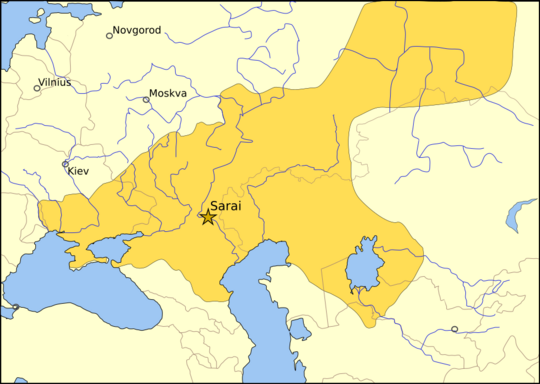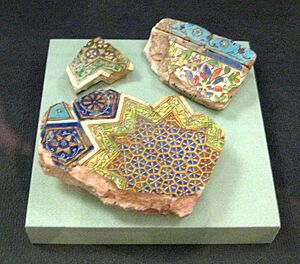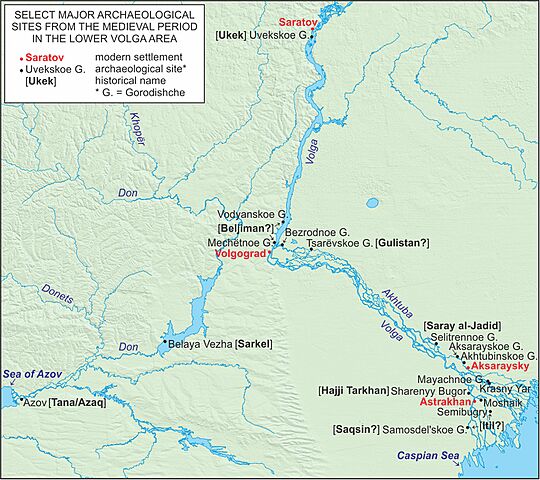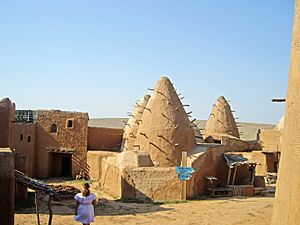Sarai (city) facts for kids
Sarai (meaning "mansion" or "court") was the name for important cities near the lower Volga River. These cities were the main capitals of the Golden Horde. The Golden Horde was a powerful kingdom that ruled much of Northwestern Asia and Eastern Europe from the 10th to the 14th century.
Historians debate if there were one or two main cities called Sarai. They also discuss where these cities were located. Names like "Sarai of Batu," "Sarai of Berke," and "New Sarai" appear in old writings.
Contents
Old Sarai
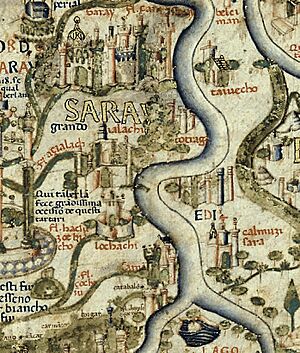
"Old Sarai" was started by the Mongol ruler Batu Khan (who ruled from 1227 to 1255). A traveler named William of Rubruck visited Batu in 1253. He wrote about "Sarai, the new town that Baatu is making on the Etilia" (the Volga River). This is the first time Sarai is mentioned in history.
Sarai was the main city for Batu, Berke, and the rulers who came after them. It was the capital of a huge empire. Many princes from Russia visited Sarai to show their loyalty to the Khan.
In 1261, Sarai became an important religious center for the Russian Orthodox Church. Later, in 1315, it also became a Catholic center. Some khans were buried in Sarai. For example, Berke was buried at "Sarai of Batu" when he died in 1266.
Berke helped the city grow, inviting Muslims to live there. This led some people to believe he founded the city. The first coins from Sarai were made during Berke's rule around 1264. More coins were made under Mengu-Timur Khan and Toqta Khan.
New Sarai
"New Sarai" was likely founded by Öz Beg Khan in the early 1300s. One old record says Öz Beg died in "New Sarai" in 1341. Another historian said "New Sarai" was built 63 years before it was destroyed in 1395. This would mean it was founded around 1334-1335.
It's not fully clear why the capital moved. Some think it was because the level of the Caspian Sea changed.
Sarai and other big cities of the Golden Horde, like Gülistan, were important for trade. They were very rich in culture. Coins marked "New Sarai" began to be made in 1342. An astrolabe (an old tool for studying stars) was found there. Many poets lived in the city, like Hisām Kātib and Sayf-i Sarāy.
However, the city's good times did not last. After 1361, there was a lot of fighting for the throne of the Golden Horde. Sarai was a rich prize, so many tried to take it. For example, the military leader Mamai captured Sarai many times between 1362 and 1376.
The Central Asian conqueror Timur attacked and burned Sarai in the winter of 1395–1396. The city started to recover by 1402 and made coins again in the 1420s. But the Golden Horde was not stable anymore.
In 1471, pirates from Russia called ushkuyniks attacked Sarai. In 1480, Russian and Crimean forces also plundered the city. The final blow came in June 1502, when Khan Meñli I Giray of Crimea sacked and burned Sarai.
What was left of Sarai was destroyed by the forces of Ivan the Terrible in 1556. Russia then built new cities like Astrakhan (1558) and Tsaritsyn (1589) in the area.
Descriptions of Sarai
The traveler Ibn Battuta visited Sarai around 1332. He called it "the city of al-Sarā, known also as al-Sarā Baraka, which is the capital of the sultan Ūzbak." It is not clear if he described Old Sarai or New Sarai.
Ibn Battuta wrote:
The city of al-Sarā is one of the finest of cities, of boundless size, situated in a plain, choked with the throng of its inhabitants, and possessing good bazaars and broad streets. We rode out one day with one of its principal men, intending to make a circuit of the city and find out its extent. Our lodging place was at one end of it and we set out from it in the early morning, and it was after midday when we reached the other end. We then prayed the noon prayer and ate some food, and we did not get back to our lodging until the hour of the sunset prayer. One day we went on foot across the breadth of the town, going and returning, in half a day, this too through a continuous line of houses, among which there were no ruins and no gardens. The city has thirteen mosques for the holding of Friday prayers, one of them being for the Shāfiʿites; as for the other mosques, they are exceedingly numerous. There are various groups of people among its inhabitants; these include the Mughals, who are the dwellers in this country and its sultans, and some of whom are Muslims, then the Āṣ (Alans), who are Muslims, the Qifjaq (Cumans), the Jarkas (Circassians), the Rūs (Rus'), and the Rūm (Romans) – [all of] these are Christians. Each group lives in a separate quarter with its own bazaars. Merchants and strangers from the two ʿIrāqs, Egypt, Syria and elsewhere, live in a quarter which is surrounded by a wall for the protection of the properties of the merchants. The sultan's palace in it is called Alṭūn Tāsh, alṭūn meaning 'gold', and tāsh, 'head'.
Another historian, Ahmad ibn Fadlallah al-Umari, who died in 1349, also described Sarai. His information might be about Old or New Sarai.
He wrote:
The city of Sarai was built by Berke Khan on the banks of the Turanian river (Volga). It is on salty soil, without any walls. The place of residence of the king is a large palace, atop which a golden crescent ... The palace is surrounded by walls, towers and houses, in which live his emirs. In this palace are their winter lodgings ... Sarai is a grand city accommodating markets, baths and religious institutions, and storages for many goods and commodities ... In the middle of it, there is a pond, the water for which comes from this river ... Uzbek Khan has built here a madrassah for religious studies, as he is very devoted to knowledge and scholars.
In the 1600s, a Russian merchant named Fedot Kotov described the ruins of Sarai:
Here by the river Akhtuba stands the Golden Horde. The khan's court, palaces, and courts, and mosques are all made of stone. But now all these buildings are being dismantled and the stone is being taken to Astrakhan.
Where Were Old and New Sarai?
For a long time, experts disagreed on where Sarai was. Some thought "New Sarai" was just a bigger "Old Sarai." Others believed they were two separate cities.
For many years, the main idea was that "Old Sarai" was at a place called Selitrennoe gorodishche. This site is near modern Selitrennoe, about 120 km north of Astrakhan. People thought "New Sarai" was at Tsarevskoe gorodishche, near modern Tsarev.
However, new studies changed these ideas. Experts now agree that Selitrennoe gorodishche (47°10′53″N 47°26′04″E / 47.1814°N 47.4345446°E) is actually "New Sarai." Tsarevskoe gorodishche (48°40′58″N 45°20′37″E / 48.6827442°N 45.3434944°E) is now thought to be the city of Gülistan. Gülistan was another important city that rivaled Sarai for a time.
The exact location of "Old Sarai" is still a mystery. Some think its ruins are hidden under "New Sarai" or were destroyed by the river. Others are still looking for it downstream from Selitrennoe gorodishche.
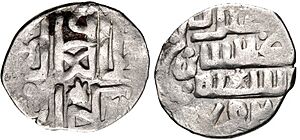
William of Rubruck's account (1254) suggests Batu's Sarai was near the start of the Volga Delta. This could fit with Selitrennoe gorodishche or a site further downstream. If "Old Sarai" and "New Sarai" existed at the same time, "Old Sarai" should be found downstream from "New Sarai."
Little Sarai
There was another city called Sarai Juk, or "Little Sarai." It was located on the lower Ural River. Sometimes, people confuse it with the other Sarai cities. This town became the main city for the Nogai Horde, another group that came after the Golden Horde. It was attacked in 1580 but later used by some Kazakh khans.
Sarai-Batu Museum and Tourist Center
Near the archaeological site of Selitrennoe gorodishche (which is "New Sarai"), there is an open-air museum called "Sarai-Batu." This place was first built in 2011 as a movie set for the film The Horde. It was also used for scenes in the TV series Sophia.
The movie sets were made of wood covered with cement and clay. They were later fixed up to be used again. These sets show what a Golden Horde city might have looked like. They combine real historical details with some fantasy.
In 2018, the sets were turned into a museum and tourist center. It's a place where you can learn about history. You can also attend historical festivals, see reenactments, ride camels, and buy souvenirs. It's a fun way to experience what Sarai might have been like!
See also
- Bakhchisaray
- Elista



